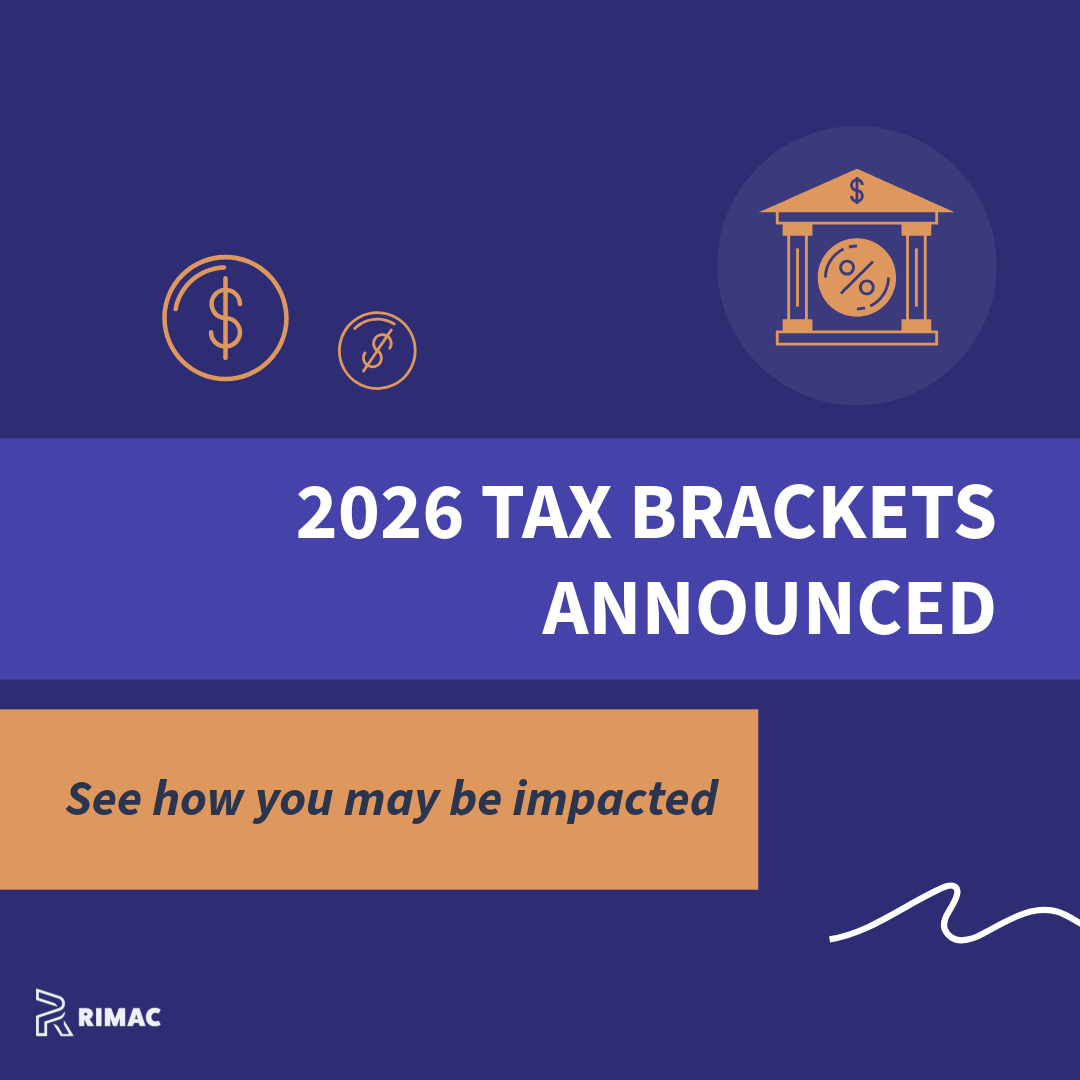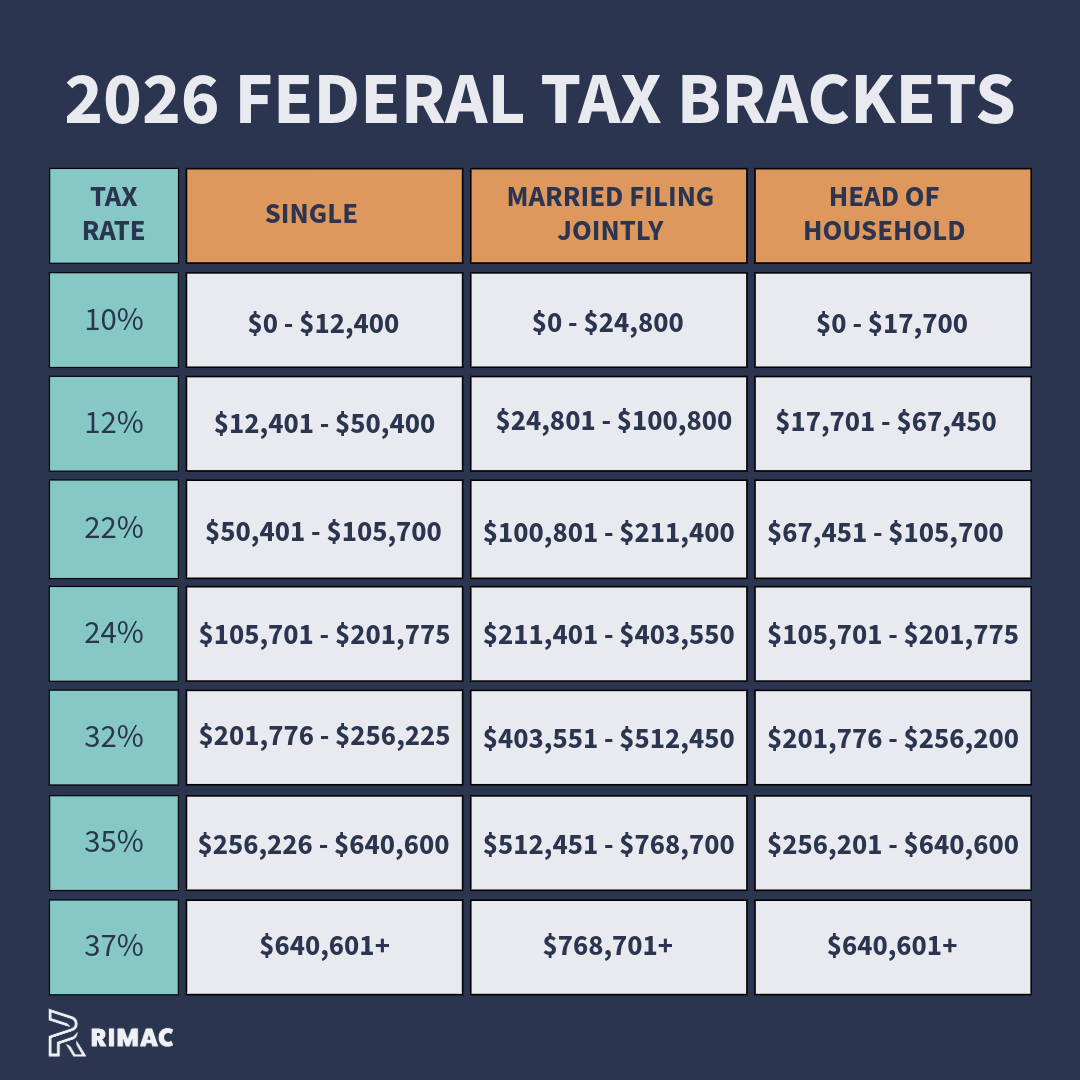IRS's 2026 Tax Bracket Changes: What You Need to Know
Key Takeaways
The Internal Revenue Service (IRS) announced new increases for the 2026 tax brackets.
Standard deductions have also been increased for 2026.
The SALT deduction cap will rise to $40,400 in 2026.
Every year, the Internal Revenue Service (IRS) evaluates tax provisions and adjusts them if necessary. As a result, the IRS has recently announced inflation-adjusted changes to the 2026 tax brackets among other provisions for the upcoming year.
2026 Federal Tax Brackets
Source: Rimac Capital
What are tax brackets?
Federal tax brackets are income ranges that determine the percentage of federal income tax you owe, based on your earnings and filing status (e.g., single, married). The U.S. tax system is progressive, meaning income is taxed at increasing rates as it rises. Each portion of your income is taxed at the rate for the corresponding bracket, not the highest rate throughout.
For example, single filers that earn more than $12,400 which is the top threshold for the 10% bracket in 2026, could owe $1,240 in federal income tax, or 10% of their first $12,400 in earnings, and then 12% on any income above that amount, up to $50,400.
Tax Brackets Changes for 2026
For 2026, the tax brackets range from 10% to 37%. These rates are the same as 2025, but the difference is the taxable income range for each rate.
For single filers, if your income is over $201,776, or $403,551 as a joint filer, your 2026 marginal rate is 32%. In 2025, the income level for the 32% marginal tax rate was anything above $197,301 for single filers and $394,601.
Here is a summary of all tax bracket changes for 2026:
10% for incomes less than $12,400 ($24,800 for married couples filing jointly). 2025 income range: less than $11,925 single/$23,850 married filing jointly.
12% for incomes over $12,400 ($24,800 for married couples filing jointly). 2025 income range: $11,925 single/$23,850 married filing jointly.
22% for incomes over $50,400 ($100,800 for married couples filing jointly). 2025 income range: $48,475 single/$96,950 married filing jointly
24% for incomes over $105,700 ($211,400 for married couples filing jointly). 2025 income range: over $103,350 single/$206,700 married filing jointly.
32% for incomes over $201,775 ($403,550 for married couples filing jointly). 2025 income range: over $197,300 single/$394,600 married filing jointly
35% for incomes over $256,225 ($512,450 for married couples filing jointly). 2025 income range: over $250,525 single/$501,050 married filing jointly
37% for incomes over $640,600 ($768,700 for married couples filing jointly. 2025 income rage: over $626,350 single/$751,600 married filing jointly.
New Standard Deduction Changes for 2026
The standard deduction is a fixed dollar amount that helps lower an individual’s taxable income. This amount varies depending on your filing status. You have two choices when you file your taxes:
Standard deduction: In this scenario, you deduct the standard deduction amount from your total income for the year. The outcome is your taxable income which is what your tax is based on.
Itemized deductions: Here the taxpayer can itemize deductible expenses such as mortgage interest, medical expenses, charitable donations and more. If these expenses add up to more than the standard deduction, the taxpayer could use this option.
Standard deduction amounts for 2026:
$16,100 for single filers and married individuals filing separately, a 2.22% increase from the current tax year’s $15,750 ($350 increase).
$32,200 for married couples filing jointly, compared to $31,500 this year 2025 ($700 increase).
$24,150 for head of households, increasing $525 from the tax year 2025.
To conclude our understanding of standard deduction, as an example, a single filer earning $100,000 of income for the year could apply the 2026 standard deduction to reduce his taxable income to $83,900. Similarly, a married couple filing jointly with a combined income of $300,000 could reduce their taxable income to $267,800.
Other Tax Provision Changes
HSAs and FSAs: Starting in 2026, taxpayers who contribute to a health flexible spending account (FSA) can contribute up to $3,400 and, if their plan permits, carry over up to $680 into the next tax year. For those with health savings accounts (HSA), the 2026 limit for contributions will rise to $4,400 for self coverage and $8,750 for family coverage.
Estate tax: This is the dollar figure for how much in assets can be sheltered from the estate tax. This federal estate-tax exclusion amount will increase to $15 million up from $13.99 million in 2025.
Tax-free gifts: For 2026, the annual exclusion for gifts remains at $19,000.
Earned Income Tax Credit (EITC): The EITC helps low- to moderate-income workers and families get a tax break. For 2026, single people that can qualify can claim $664 on their tax returns, compared to $649 in 2025. Similarly, the maximum EITC amount that a family can claim in 2026 will be $8,231, up from $8,046 in 2025, however, it is important to note that this only covers qualifying households with three or more children.
Child Tax Credit of $2,000 with a refundable amount of $1,700 will remain the same.
Tax Effects of the ‘Big, Beautiful Bill’
Alongside the IRS’ inflation adjustments making changes to what people’s 2026 tax picture may look like, the OBBBA may have some effects on what they pay as well.
Cap on itemized deductions: Those in the 37% tax bracket will notice a new 35% cap on itemized deductions. This means that instead of getting 37 cents on the dollar for itemized deductions, these filers will get 35 cents on the dollar..
SALT deduction increases: The biggest increase to the state and local tax (SALT) deduction limit was seen this year, when it jumped from $10,000 to $40,000. But that increase will continue in 2026, when it will rise again to a limit of $40,400.
Connect with Us Today
Schedule a free 30-minute consultation call. We’ll learn more about your priorities and ensure we can answer all of your questions.


